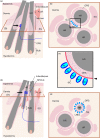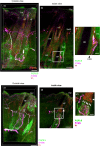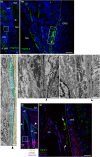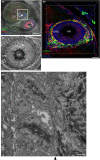Three-dimensional correlative light and focused ion beam scanning electron microscopy reveals the distribution and ultrastructure of lanceolate nerve endings surrounding terminal hair follicles in human scalp skin
- PMID: 36774410
- PMCID: PMC10184541
- DOI: 10.1111/joa.13831
Three-dimensional correlative light and focused ion beam scanning electron microscopy reveals the distribution and ultrastructure of lanceolate nerve endings surrounding terminal hair follicles in human scalp skin
Abstract
Lanceolate nerve endings (LNEs) surrounding hair follicles (HFs) play an important role in detecting hair deflection. Complexes of the LNEs form a palisade-like structure along the longitudinal axis of hair roots in which axons are sandwiched between two processes of terminal Schwann cells (tSCs) at the isthmus of HFs. The structure and molecular mechanism of LNEs in animal sinus hair, pelage, and human vellus hairs have been investigated. Despite the high density of HFs in human scalp skin, the LNEs in human terminal HFs have not been investigated. In this study, we aimed to reveal the distribution and ultrastructure of LNEs in terminal HFs of human scalp skin. Using light-sheet microscopy and immunostaining, the LNEs were observed at one terminal HF but not at the other terminal HFs in the same follicular unit. The ultrastructure of the LNEs of terminal HFs in human scalp skin was characterized using correlated light and electron microscopy (CLEM). Confocal laser microscopy and transmission electron microscopy of serial transverse sections of HFs revealed that LNEs were aligned adjacent to the basal lamina outside the outer root sheath (ORS), at the isthmus of terminal HFs, and adjacent to CD200-positive ORS cells in the upper bulge region. Moreover, axons with abundant mitochondria were sandwiched between tSCs. Three-dimensional CLEM, specifically confocal laser microscopy and focused ion beam scanning electron microscopy, of stained serial transverse sections revealed that LNEs were wrapped with type I and type II tSCs, with the processes protruding from the space between the Schwann cells. Moreover, the ultrastructures of LNEs at miniaturized HFs were similar to those of LNEs at terminal HFs. Preembedding immunoelectron microscopy revealed that Piezo-type mechanosensitive ion channel component 2 (Piezo2), a gated ion channel, was in axons and tSCs and adjacent to the cell membrane of axons and tSCs, suggesting that LNEs function as mechanosensors. The number of LNEs increased as the diameter of the ORS decreased, suggesting that LNEs dynamically adapt to the HF environment as terminal HFs miniaturize into vellus-like hair. These findings will provide insights for investigations of mechanosensory organs, aging, and re-innervation during wound healing.
Keywords: correlative light and electron microscopy; focused ion beam scanning electron microscopy; immunoelectron microscopy; lanceolate nerve endings; light-sheet microscopy; miniaturized hair follicles; palisade nerve endings; terminal hair follicles.
© 2023 Anatomical Society.
Conflict of interest statement
The authros declared that they have no conflict of interest.
Figures










References
-
- Blanpain, C. , Lowry, W.E. , Geoghegan, A. , Polak, L. & Fuchs, E. (2004) Self‐renewal, multipotency, and the existence of two cell populations within an epithelial stem cell niche. Cell, 118, 635–648. - PubMed
-
- Blume, U. , Verschoore, M. , Poncet, M. , Czernielewski, J. , Orfanos, C.E. & Schaefer, H. (1993) The vellus hair follicle in acne: hair growth and sebum excretion. British Journal of Dermatology, 129, 23–27. - PubMed
MeSH terms
LinkOut - more resources
Full Text Sources
Research Materials
Miscellaneous

